Giant’s Defy is the brand's best selling road bike. The TCR may have the kudos of being Tom Dumolin’s bike of choice, and the Propel has all of the aerodynamic bells and whistles to make it a pure superbike, but it’s the Defy that's aimed at everyday riders like us that bring the most revenue to the ‘world's biggest bike manufacturer’.
- The Giant Defy Advanced Pro 0 is one of our Bike of the Year bikes for 2019 and has been crowned our best comfort road Bike of the Year. To read reviews of the other contenders and the categories tested across road, mountain and women's bikes, visit our Bike of the Year hub page.
- Best road bikes 2019: how to choose the right one for you
- Road bike groupsets: everything you need to know
That means Giant pays a lot of attention to the Defy, it’s not an also ran, it is more often than not a proving ground for Giant’s latest tech.
The last generation Defy was the first mainstream bike to go disc only, it (along with the TCX cyclocross bike) also debuted Giant’s vibration crushing D-Fuse seatpost design, which is now imitated on bikes from premium brands such as BMC, Cervelo, Specialized and more.
The D-shaped D-Fuse seatpost has provided the inspiration for another another D-Fuse concept by applying the same tech to a handlebar. This is a tougher call because you don’t want overly flexing bars that will be detrimental to handling, but you want to have enough to smooth the vibrations.
The new Contact SLR carbon D-Fuse handlebar has a similar D-shaped profile, the carbon cross-section is 19mmx35mm and the shape is orientated so it complies when being ‘pushed’ from above when you hit a rut or pothole. Giant claims 10 percent more compliance than the standard Contact SLR bar and remains stiff when you ‘pull’ when sprinting or climbing hard out of the saddle. Here Giant claims an increase in stiffness of a huge 30 percent.
Giant claims that the bar working in conjunction with the seatpost provides more than enough compliant comfort without having to resort to complex pivots, inserts or suspension, as seen on some of its rivals.
The frame's reshaping and the new fork profile Giant has also given provision for bigger tyres too, with the new Defy able to take a large 32c with ease and that’ll certainly help on the compliance front. Giant sees the Defy being used for a wide variety of uses — racing, (it has UCI frame approval), commuting, riding sportives — and with that large tyre capacity you could even use it for lighter-gravel duties.
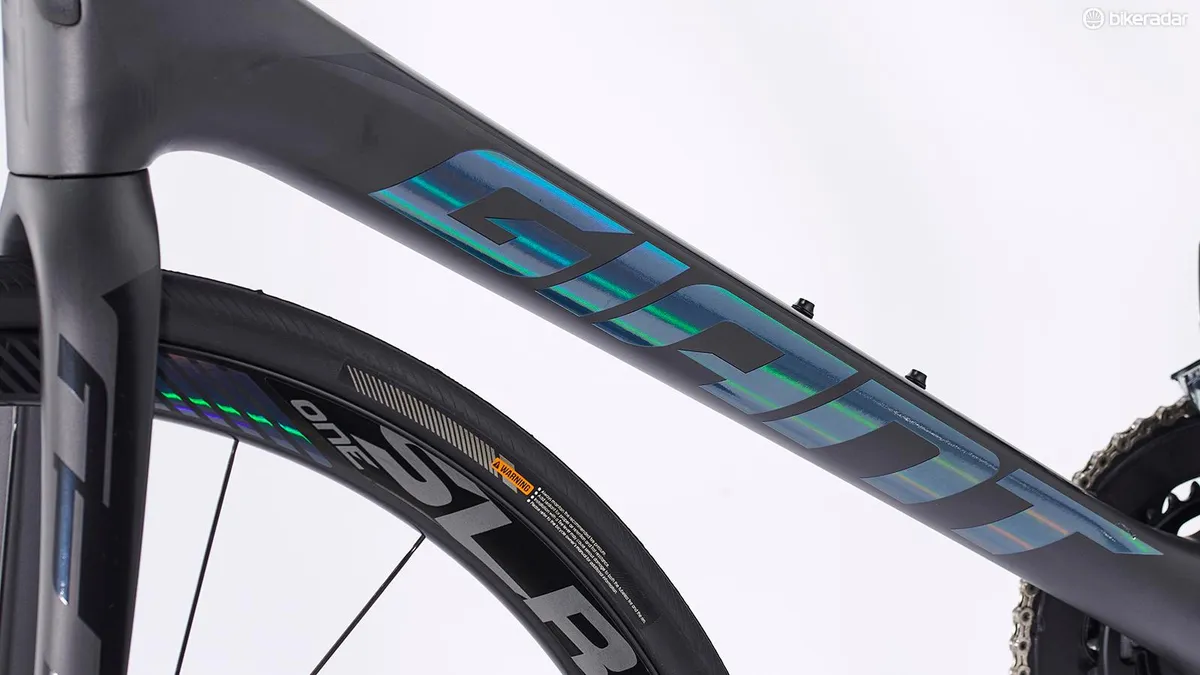
The geometry has been tweaked to retain the same excellent Defy handling with bigger rubber, and even mudguard mounts have been provided, so you can protect yourself from the elements when riding up to a 28mm wide tyre. Oh, and it comes with tubeless tyres too, making all-too common pinch punctures a thing of the past.
Giant Power Pro meter
Perhaps the most surprising addition to the Defy’s specification is a new Giant Power meter, called the Power Pro. It was developed, designed and manufactured completely in house.
It has been engineered with multiple sensors for both left and right crank arms and can display multiple metrics: watts, pedal balance, force angle and cadence.
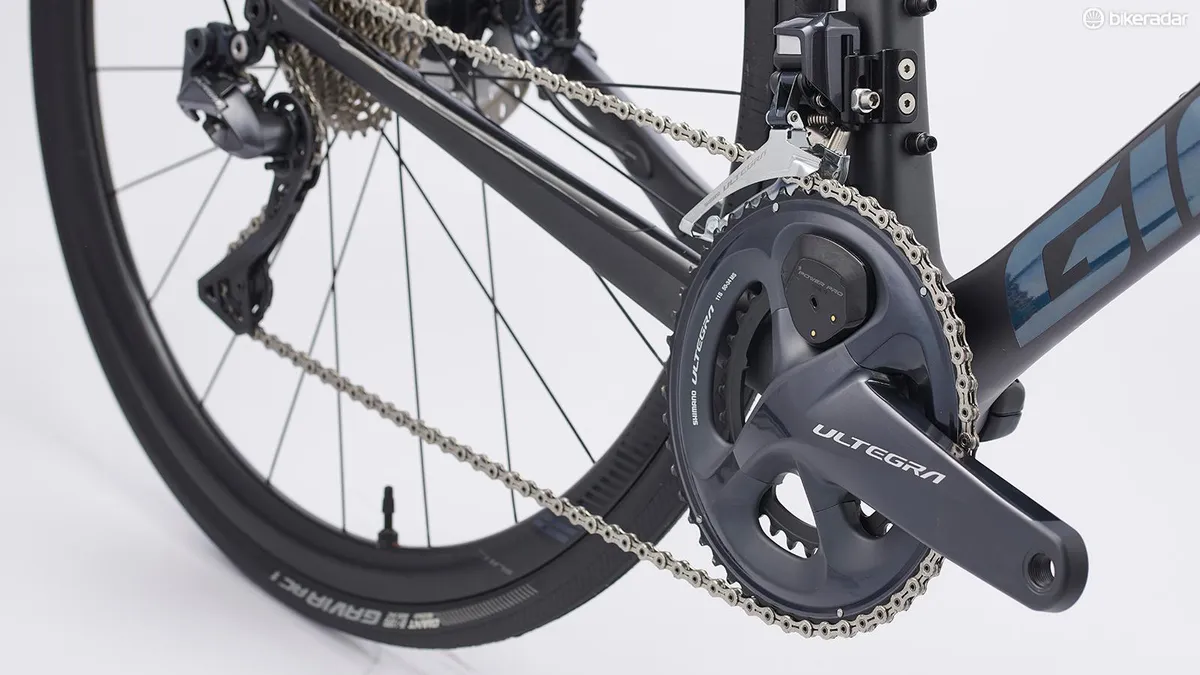
It can either pair with Giant’s own Neostrack GPS computer or any ANT+ compatible unit, such as a Wahoo or Garmin head unit. Battery life is a claimed 150 hours, or 1,500miles, on a single charge and it can be easily recharged in situ. An LED indicator on the crank shows current battery level or you can see more detailed information via Giant’s own Ridelink app. The app is also where firmware upgrades can be installed.
The bike looks superbly slick with the Propel-like stem providing a hiding place for all of the cables
Giant tells us the meter has received extensive testing for waterproofing, heat and temperature, salt corrosion, UV, vibration, fatigue testing and impact tests. Its rated to IPX7 for waterproofing and tested for storage temperature from between -20c to +79°C and a working range of between -10 and +50°C.
The meter will only be available on Giant’s premium bikes for 2019 with the aim of making it available aftermarket in 2020, with a guide price of around £1,000. So to see it come fitted to a bike priced at £4,500 is a first.
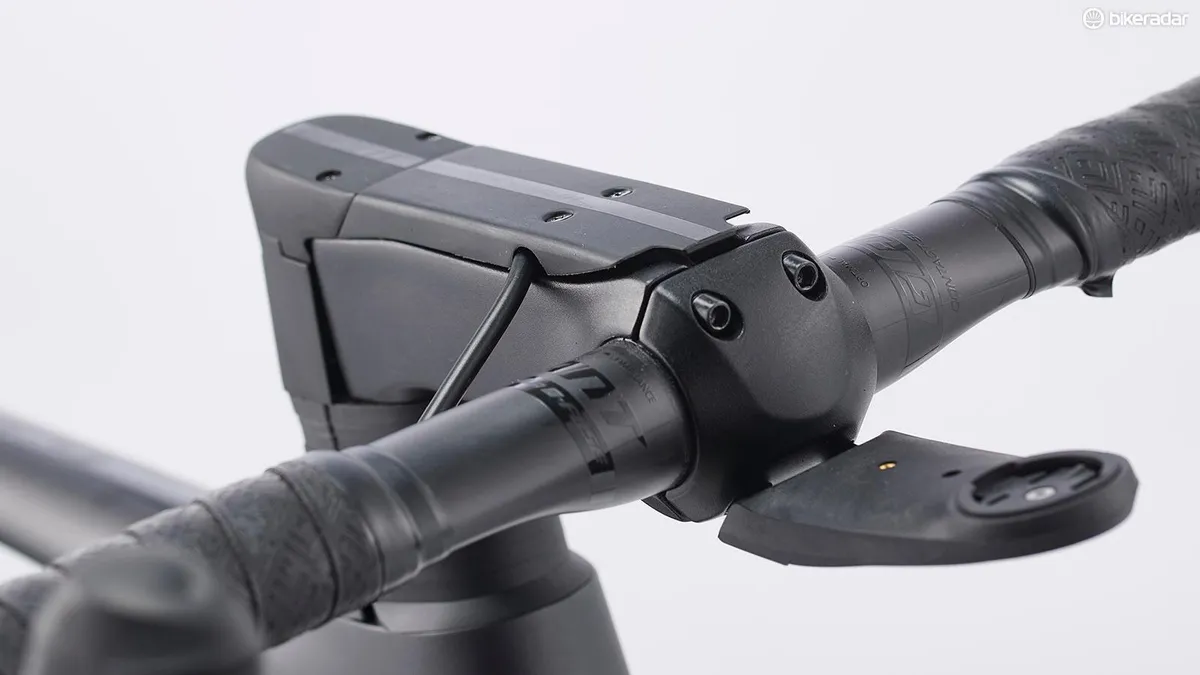
The power meter charges with a split USB cable, which will fit to any wall charger or powered USB port and attaches using magnetic connectors to the crankset on the spider side and the left arm crank. The LEDs will change from red to green when fully charged.
Giant Defy Advanced Pro 0 ride impressions
My test rides on the Pro 0 started in Italy and included ascents of the Gavia and the Mortirolo, as well as a whole bunch of rolling terrain between. Testing then returned to the UK on much more familiar roads with less gargantuan climbs.
The Defy Advanced Pro 0 comes across as a bike purpose-built for challenging days out. Although you can certainly find lighter, my test bike with pedals, Garmin mount and two bottle cages weighed 8.78kg, but the weight is just a number because it rides light.
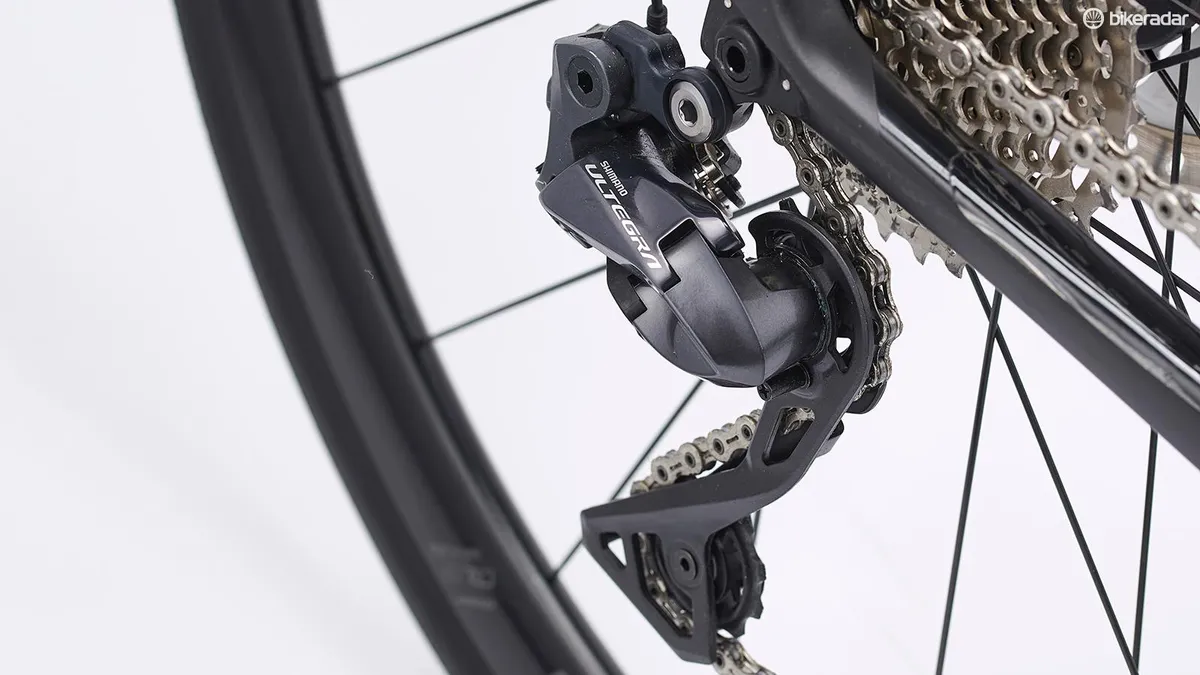
I think much of this is down to the fine Giant carbon SLR wheels and impressive 28c rubber, which was setup tubeless (as it should be), having plenty of life with quick pick-up, smooth rolling and little detrimental lateral flex.
The bike looks superbly slick with the Propel-like stem providing a hiding place for all of the cables, which then route internally through the bike keeping the Defy’s fine lines unhindered.
The ride quality is up with the very best, the frame and fork have a purposeful solidity, the pedal reactions and speed pick-up feel every inch as efficient as my TCR Advanced SL Disc, but this is complemented by a brilliant ability to absorb road chatter.
It's every inch a match for the likes of Cannondale’s Synapse and Canyon’s Endurace and close to Trek’s Domane, Specialized’s Roubaix, Lapierre’s Pulsium and Wilier’s Cento10NDR without having to resort to pivots, elastomers or any other add ons.
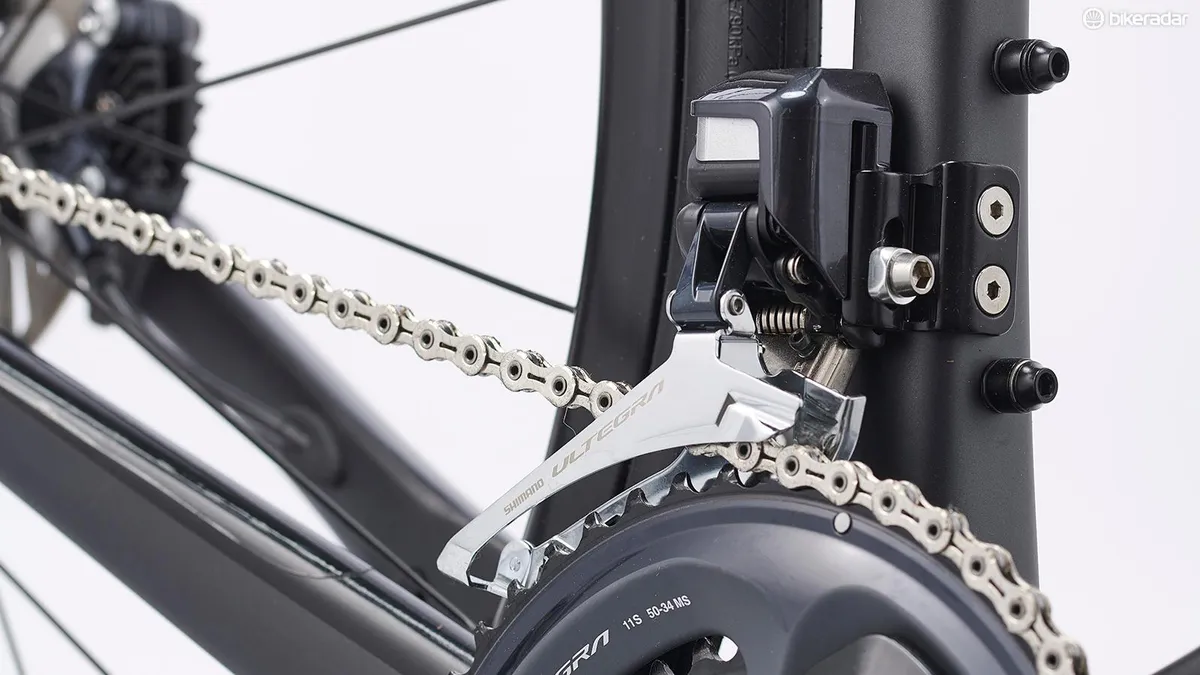
On a beast of a climb like the Gavia I think you learn more about yourself than you do about a bike, and I learned that I’m now a bigger fan of Shimano’s ever-so-versatile Ultegra Di2 group than I was before.
The 52/36 pro-compact up front combined with a super wide 11-34 at the back was pretty much the ideal range for me. I’d like to be able to say the 34 was superfluous to proceedings in all but the steepest double-digit gradients, but I used it far more than that. Having a gear you can spin when your legs are loaded with lactic acid is a boon, so pish to the 11-25 pro wannabes, I’m all for taking advantage of technical advancements like this.
More on that power meter
When I picked up my bike it was set up with Giant’s own GPS, which had me wondering about it’s compatibility or usability, but I switched that out for my trusty Garmin, synced in the Power meter (which has a proper name not just a code number), calibrated it from my Edge 1030 in seconds and rode away without any hitch or surprises.
Comparing it to my usual meter readings (a Quarq D-Zero) the Giant unit read a couple of watts higher on average, and the left right balance a bit more pronounced (I’m 45/55 on the Quarq, 43/57 on the Giant), but close enough for me so as not to have any concerns, and actually pretty close to the Shimano meter I run on one of my other bikes.
After more use of the unit, and a few firmware updates, the Giant meter has proved accurate and consistent, and the Apple-like magnetic charger is a smart piece of design too.
When the road starts to fall and you get into the meat of a descent the Defy is an impressive handling bike, despite the front end being too tall for my liking. It still responded quickly with spot-on balance to hold a fast line and really cut into the corners with confidence. On the climbs the new D-Fuse bar feels as stiff as any carbon bar, so Giant’s claims of its compliance seemed just that — claims.
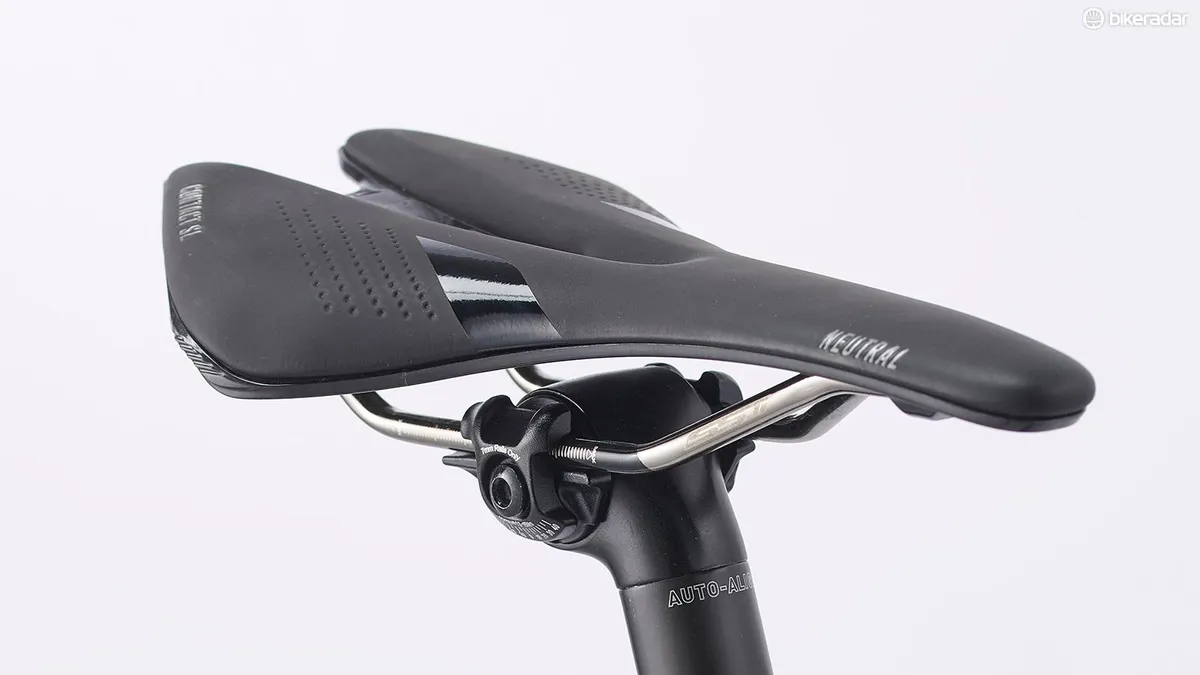
But the D-Fuse bar came into its own on the descent of the Gavia. This legendary climb is for the most part pretty smooth, with some big exceptions. At the first steepening of the descent the road becomes a mixture of ripples, split surfaces and some devilishly deep ruts and potholes where line choice becomes all important and you need to throw in a bunny hop or two to clear hazards. Back in the UK, and especially on the South West’s poorly maintained road surfaces, the Defy is more impressive, more of the time.
When in the drops of the D-Fuse bar the flex when you hit a bump in the road is pronounced and it works in conjunction with the D-Fuse post, making for a smoothing path through the worst surfaces. If you do find the D-Fuse bar a little too compliant it can be rotated a little fore and aft at the stem, which will offset the D-shape for less force acting on the flexing area and therefore make it a little stiffer.
As much as I am mightily impressed with the new Pro 0, its not without its niggles. The Contact SL saddle in its flat neutral version felt a bit too flat and firm to me and that’s despite a generous layer of high density padding. I’d prefer either a more swoopy Fizik Aliante-style shape or a short more padded saddle such as a Specialized Power, Prologo Dimension, or Selle Italia Novus Boost.
Though saddles are a personal preference, I admit, what I would like to see changed is the disc rotor up front. On an XL bike your going to find riders like me, at around 6ft2in+ and by default heavier, and although the standard 140mm rotor fitted did stop me every time without fail, it did quite quickly start to screech in protest at being relied upon.
I run all of my own bikes with a 160mm up front and I prefer the increased control it affords, and certainly that it's far less anti-social when it comes to unwanted noise.
Giant Defy Advanced Pro 0 specifications
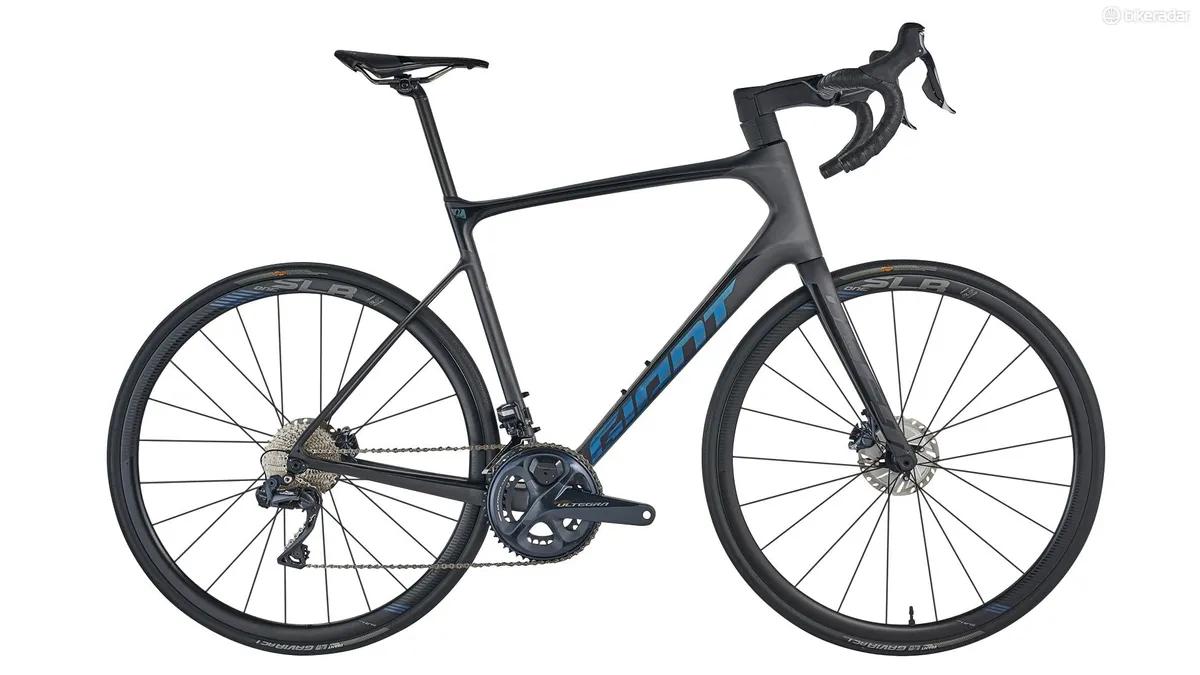
- Sizes (*tested): S, M, M/L, L, XL*
- Weight: 8.78kg (including Garmin mount, two bottle cages, Shimano 105 composite pedals)
- Frame: Advanced-Grade Composite
- Fork: Advanced-Grade Composite
- Chainset: Shimano Ultegra with Giant Power Pro Double Sided Power Meter
- Bottom bracket: Shimano Press Fit
- Cassette: Shimano Ultegra, 11-34
- Chain: KMC
- Mech: Shimano Ultegra Di2
- Shifters: Shimano Ultegra Di2
- Wheelset: Giant SLR-1 Disc carbon, tubeless
- Tyres: Giant Gavia AC 1 tubeless 28c
- Stem: Contact SL Stealth
- Bar: Contact SLR D-Fuse carbon
- Saddle: Contact SL (neutral)
- Seatpost: Giant D-Fuse SL composite
- Brakes: Shimano Ultegra hydraulic disc with 140mm rotors
- Extras: RideSense Bluetooth sensor
Giant Defy Advanced Pro 0 geometry
- Seat angle: 72.5 degrees
- Head angle: 72.5 degrees
- Chainstay: 42cm
- Seat tube: 56.5cm
- Top tube: 59.5cm
- Head tube: 22.5cm
- Fork offset: 5cm
- Trail: 5.8cm
- Bottom bracket drop: 7cm
- Wheelbase: 1,040mm
- Stack: 62.4cm
- Reach: 39.8cm
BikeRadar would like to thank Stolen Goat, Lazer, Northwave and Effetto Mariposa for their help and support during our Bike of the Year test.
